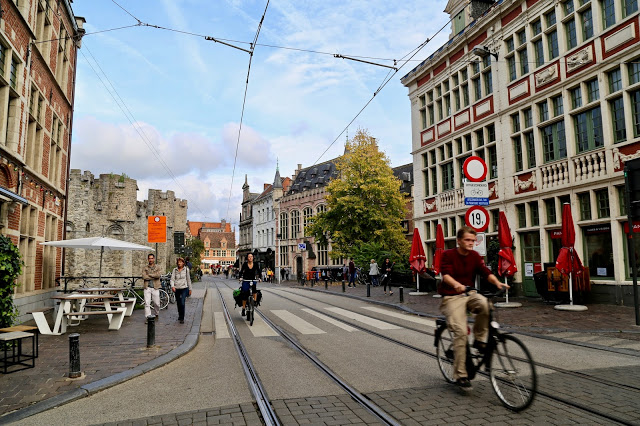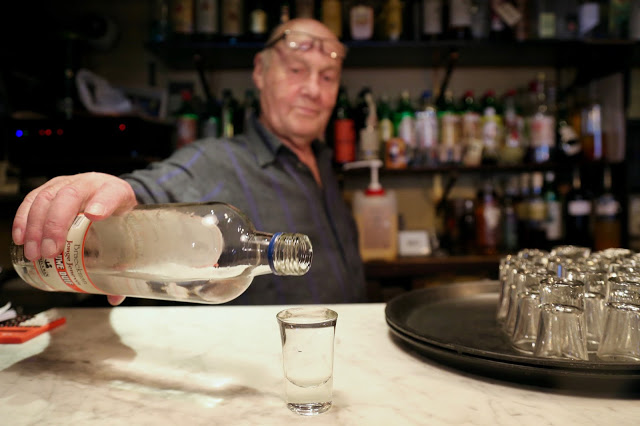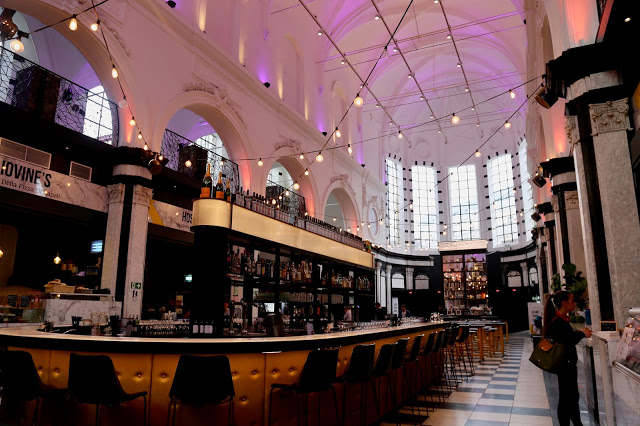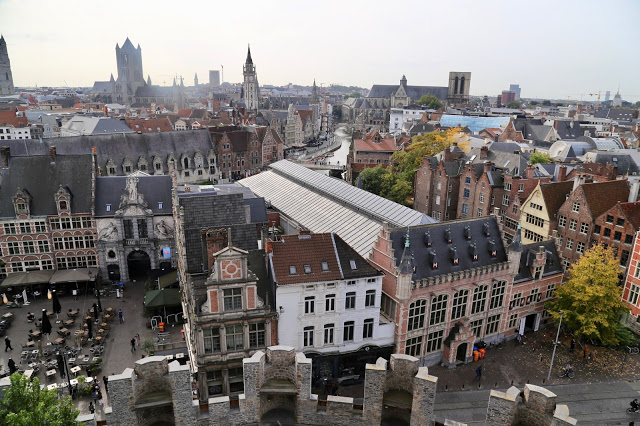







Ghent is like Bruges but without the Disneyfied atmosphere of a museum city. It’s lefty, hippy and vibrant, partly thanks to the population of 75,000 students. It’s also one of the most beautiful towns I’ve ever visited. This ancient city is built on a complex system of waterways and canals, weaving through half timbered medieval architecture, characteristic stepped gables which zigzag across the sky, while trams rattle along the cobbled streets as bicycle and church bells reverberate like glockenspiels. Ghent also has the world’s largest number of vegetarian restaurants per capita.
I met Maureen Vande Cappelle, part of a Belgian organisation called EVA ‘Encouraging vegetarian alternatives’, at Le Botaniste, a vegan restaurant housed in an old pharmacy in the centre of Ghent.
Every Thursday, restaurants, schools, workplace canteens, government offices, are encouraged to provide a vegetarian or vegan meal as the main choice. This initiative started in 2009 and is now, eight years on, part and parcel of Ghent life. Why can’t we do this in the UK? One of the founders of EVA is Tobias Leenaert who wrote ‘How to create a Vegan World, a pragmatic approach’. (I agree with him that some vegan purists can be off-puttingly negative to flexitarians and this is not the way forward).
Maureen and I, we worked out, had come across each other before, at the Anti-G8 camp in Stirling. She, like me, coming from an activist background, was part of Rampenplan, a Dutch anarchist food truck, which made, I recollect, particularly delicious food. We reminisced about cooking for hundreds of activists while surrounded by riot police.
The political situation is Belgium is also delicate. In Flemish towns like Ghent, I was told, they prefer you to speak English rather than French. There is a rivalry between the Flemish and French speaking parts of Belgium, in fact some maintain that there is no such thing as Belgium at all. The northern part is Flanders, next to Holland while the southern end, near the French border, is Wallonia.
Strangely Lille is considered part of Flanders even though it’s in France and they speak French.
One thing I found strange in Ghent which after all has its fair share of tourists, is that most menus are not translated into English, however virtually everyone can speak very good English.
What to eat and drink in Ghent:

Ghent ‘noses’

Cuberdons or Ghent ‘noses’ are cone shaped sweets, traditionally violet flavoured but now in liquorice, cherry, raspberry and other flavours. They should ideally be eaten fresh, as the liquid interior dries up after a couple of days. Five euros will buy you nine cuberdons.
Mustard:



The mustard Tierenteyn is a good gift to take home, beautifully wrapped by the historic shop Tierenteyn-Verlent, opened in 1790, which still makes it fresh in the basement. A girl will scoop the mustard out of a large wooden barrel into a glass, plastic or ceramic container. Prices are from a couple of euros for a small jar.
They also sell jars of citrussy yellow piccalilli.
Gin/Jenever:




I prefer Dutch and Belgian style ‘Jenever’ to English gin – it’s smooth, needs no mixers and can be slowly sipped. A fantastic place to try them out is t’ Dreupelkot, a historic, dimly lit bar which gives you the first gin shot on the house. The walls are lined with freckled brown ceramic bottles on creaky wooden shelves. There are dozens of different flavours such as chocolate or banana, my favourite is the unlikely sounding Green Apple, which tastes like alcoholic sour sweets.
Waffles:

The Belgians are famous for waffles, thick like doughy mattresses, squirted with feathery duck down cream and chocolate sauce. The inventor of the Belgian waffle was Max Consael of L’Etablissement Max, which was founded in 1839. You can visit his descendant Yves and try this speciality baked in one of the 12 original waffle irons at the new Etablissement Max.
Stoverij:

Stoverij is usually a slow cooked beef stew cooked down with Belgian beer and mustard; I had a vegan version stoverij with seitan at Mosquito Coast restaurant opposite the Vegan BnB. It wasn’t great to be honest, the seitan was rubbery and tasteless, but the potato croquettes served with it, were fantastic.
Waterzooi:
Originally this was a fish stew but today is usually made with chicken. I don’t know of any vegan/vegetarian restaurants that serve this as yet. Let me know in the comment if you know of any in Ghent.
Beer:



Belgium is famous for its beer and Ghent is no exception. I drank at a really odd brown café, the ceiling cluttered with hanging rusty bicycles, called ‘T Velootje, run by eccentric landlord Lieven De Vos. When I visited he was wearing women’s tights under some yellow shorts.
‘What do you want to drink?’ he asked.
‘What have you got?’ I replied
‘I’m going to give you beer’ he said handing me a bottle of something delicious. .
He chooses. You drink it. The customers all talk to each other, just like in a good pub, which is perfect when you are travelling alone.
Belgian Fries:

Where to eat in Ghent:


Le Botaniste was started by Alain Coumont, who also started Le Pain Quotidien, which is not French but Belgian. (I have a little theory that all the best French people are actually Belgian: Jacques Brel, Tintin, Georges Simenon, Hercules Poirot, Smurfs, Charlemagne, Jean Claude Van Damme, Plastic Bertrand). Coumont believes that a plant based diet is the future, and his new project is Le Botaniste. There are two branches at present – Ghent and New York, but Coumont hopes that Le Botaniste will be as successful world-wide as Le Pain Quotidien.


Lepelblad had only been open for 2 days when I visited. I had tacos and a cocktail, all sourced from local suppliers where possible and admired the old fashioned Aga, which wasn’t working.
I didn’t manage to eat in many places, as I was only in Ghent for a day and a half, and you need at least 3 days, but I got some great recommendations from Maureen:
- Madam Bakster The Guiltfree Bakery: a selection of vegan cakes and bakes.
- Full Circle Coffee: All vegan new wave coffee bar, which serves pies and brioches. They serve coffee with oat milk (which is nicer then soy milk).
- Lokaal: the name of this ‘teabar’ means ‘local’, they source everything from nearby while remaining organic, veggie and vegan.
- Food Storms at Nest: a pop-up cafe in the Old Library, until April 2018, maybe longer. Starting from mid-October Foodstorms will feature a vegan tasting menu by Kevin Storms, a well known chef in Ghent.
- De Superette: This is not a veggie/vegan place, but is apparently worth a visit thanks to the wonderful fresh sourdough bread and pizza baked in the wood oven. Set up by chef Kobe Desmalaults, Ghent’s rock and roll chef, they also do vegan and vegetarian options.

- V-box: originally they provided vegan street food but are now new fast-food kid in town, according to Maureen.
- Way: provide a vegan option every day.
- BeO: an organic shop with a lunch place attached. Cheap good organic produce in a nice setting.
- Dochters van de jaegher: run by two sisters, this is an ironically named vegetarian or pescatarian canteen ( ‘daughters of the hunter’) based in the old Hinkelspel cheese factory. They also sell cheese and fresh produce.
Non-veggie:


Where to visit in Ghent:

You can also hire bicycles or kayaks. I rather like the idea of roaming around the network of canals under your own steam.
I recommend buying the CityCard Gent which allows access to all museums, historical sites, a guided boat tour, the hop on, hop off boat, and all public transport. 30 euros for 48 hours, 35 euros for 72 hours.

- The 12th century Gravensteen Castle is atmospheric, with interesting exhibitions and great views over the city.


- The Museum Dr Guislain, housed is an enormous sanitorium, is quirky and worth visiting. Dr Guilhas was one of the pioneers in mental health in Belgium, you can find out more about treatments, conditions, the history of psychiatry. There are also art exhibitions and a cafe.
- The ‘STAM’ Ghent City Museum is vast and modern. In the first rooms, you are given overshoes so that you can walk over a map of the city; like treading over an up lit Google Earth. In other parts of the museum you explore the history of Ghent from 1200 to the present day. In 1400 Ghent was as big as Paris and equally important.
I loved the shop Dille and Kamille, which while Dutch in origin, has many branches in Belgium. I bought enamel bowls, serving spoons, wooden moulds for butter (sheep) and speculoos biscuits, a red and white checked apron. I could have spent a great deal more. Great for food styling props. When are they going to open in the UK?
Where to stay in Ghent:


Aanaajaanaa off the main square is a charming BnB in a tall old 19th century house. There are only two rooms which are huge. Rates are around 100 euros a night with breakfast for one or two people.
It’s owned by Markus and Carol who live downstairs with their children. Markus was very friendly and helpful, his children helped served a delicious vegan breakfast with a freshly made smoothie. The colour scheme, everything saffron, orange or red looks Buddhist.
Markus explained, as he carried my case up the steep dark wooden stairway:
‘We can’t say we’re vegan because of the wool rugs and blankets but we don’t want to throw them out but the breakfast is completely vegan’.
How to get there:

Eurostar from London takes less than three hours, change at Brussels and get a local train to Ghent- 30 minutes away.
I was hosted on this trip by VisitFlanders and VisitGent.





Definitely not vegan or even vegetarian but I could drink in the history and architecture and certainly could get by on gin and waffles!
Gin and waffles – what a great diet! 🙂
Seems easy to get there and from your pictures a lovely place to go. All very yum.
Update. We have booked to go to Ghent for 3 days on the strength of your article. Would not have thought of Ghent otherwise. Staying in old part hotel Gravensteen.
that looks delicious!!! now i want to go to ghent.Thanks